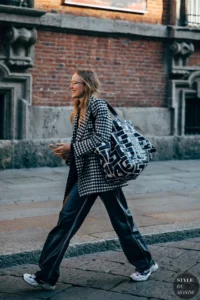European fashion is known for its flair, refinement, and innovation. It’s how folks in Europe showcase themselves through clothes, accessories, and trends. From the trendy roads of Paris to the lively markets of Italy, European fashion mirrors a diverse cultural legacy mixed with contemporary influences. Whether it’s timeless styles from high-end labels or unique streetwear from emerging designers, European fashion provides a variety for all. Let’s explore the vibrant universe of European style!
Table of Contents
- Foundations of European Style
- Trends Through the Ages
- Fashion Capitals of Europe
- European Fashion Icons
- Influence of European Fashion Today
- European Fashion Trends

European-Fashion
Foundations of European Style
Influence of European Culture and Art
European fashion has been deeply influenced by its rich cultural and artistic heritage. From the Renaissance’s emphasis on classical beauty to the opulence of the Baroque and the playful refinement of Rococo, European art movements have shaped fashion’s evolution. The 19th and 20th centuries brought further innovation, with movements like Impressionism and Expressionism encouraging designers to experiment with form and color, making fashion a true art form.
Iconic Designers and Fashion Houses
European designers like Coco Chanel, Christian Dior, Yves Saint Laurent, Giorgio Armani, and Valentino Garavani have made lasting contributions to the fashion world. Chanel’s classic black dress and suit, Dior’s influential “New Look,” and Saint Laurent’s innovative ready-to-wear clothing have stood the test of time. Italian designers Armani and Valentino have also played a significant role in setting global fashion standards with their exceptional craftsmanship and style. These designers have not only created long-lasting fashion trends but have also mirrored and impacted cultural and social shifts.
Trends Through the Ages
Renaissance Elegance
During the Renaissance period, European fashion was characterized by opulence and elegance. Rich fabrics like velvet and silk were favored, adorned with intricate embroidery and embellishments. Experts note that this era marked a shift towards tailored clothing and the emergence of structured silhouettes, reflecting the growing influence of art and culture.
Rococo Extravagance
In the 18th century, European fashion took on a more extravagant and frivolous style known as Rococo. Women’s clothing featured elaborate designs, including voluminous skirts, corsets, and intricate lace details. Fashion historians emphasize that this period was marked by a celebration of luxury and excess, with clothing becoming a symbol of social status and wealth.
Modern Minimalism
In the 20th and 21st centuries, European fashion underwent a transformation towards minimalism and simplicity. Clean lines, neutral colors, and functional designs became prevalent, reflecting a shift towards practicality and comfort. Experts highlight that modern European fashion prioritizes versatility and wearability, with an emphasis on timeless pieces that transcend fleeting trends.
Fashion Capitals of Europe
Paris is known for being very stylish
The city’s streets are filled with stylish Parisians, and iconic brands like Chanel and Dior debut their latest creations here. Paris Fashion Week is a highlight, setting global fashion trends. The city’s historic and romantic charm provides a perfect backdrop for its chic fashion scene.
Milan combines tradition and innovation
Milan blends the old with the new in fashion. It’s home to luxury brands like Gucci and Prada, known for exquisite craftsmanship. Milan Fashion Week showcases both traditional and cutting-edge designs. The city’s fashion scene honors its rich heritage while embracing innovative trends, making it a dynamic fashion hub.
London is diverse and bold
London’s fashion is diverse and bold, reflecting the city’s multicultural vibe. Known for its eclectic style, London is a place where creativity flourishes. London Fashion Week features groundbreaking designs from icons like Alexander McQueen. The city’s streets, from edgy Shoreditch to elegant Mayfair, showcase a wide range of fashion expressions.
Passion and flair define Madrid
Madrid’s fashion scene is vibrant and full of passion. Spanish designers bring a unique blend of tradition and modernity to their creations, often featuring bold colors and dramatic designs. Madrid Fashion Week highlights this energetic spirit, with collections that are lively and innovative. The city’s street fashion and markets reflect this joyful and passionate approach to style.
Berlin is known for its innovative and trendy style
Berlin stands out with its edgy and avant-garde fashion scene. Known for its experimental and unconventional style, Berlin Fashion Week features innovative and sustainable designs. The city’s fashion reflects its urban and gritty charm, with influences from streetwear and punk. Berlin’s fashion is always evolving, embracing new ideas and pushing boundaries.
European Fashion Icons
FAQ
What is European fashion known for?
European fashion is famous for its elegance, high-quality materials, and stylish designs. It often sets global trends.
What is Haute Couture?
Haute Couture means high-end, custom-made fashion, often very exclusive and handmade with great detail.
How does European fashion differ from American fashion?
European fashion focuses on quality and classic style, while American fashion is more about comfort and practicality.
Source By : – https://in.pinterest.com/
Written By :- Bioleather.in
